|
|
ARMENIAN TERRORISM IN THE 20TH CENTURY
Michael M. Gunter
Dept. of Political Science
Tennessee Technological University
|
|
|
| |
Tacitly supported by many Armenians and others throughout the world
as legitimate revenge for what most observers viewed as genocide [1] in World War I, Armenian terrorism in the 20th century was an excellent
example of how one person's terrorist can be viewed by some as another's freedom fighter.
In seeking revenge for past perceived wrongs and eventual independence, Armenian terrorism
also shared common characteristics with such other ethnic-based terrorist movements as the
Irish and Palestinian, among others. In another sense, however, Armenian terrorism, as
well as its support in the larger Armenian community, was unique in its visceral hatred of
its enemy, in this case the Turks. Also unique was how Armenian terrorism manifested two
separate periods of activity separated by almost half a century: 1) The period immediately
after World War I when a secretive Armenian organization called Operation Nemesis
assassinated several former Ottoman officials, and 2) the period from approximately
1973-1985 when the Marxist Armenian Secret Army for the Liberation of Armenia (ASALA) and
its more right-wing nationalist rival the Justice Commandos of the Armenian Genocide (JCAG),
after July 1983, the Armenian Revolutionary Army (ARA) assassinated numerous Turkish
diplomats as well as a number of third parties. [2]
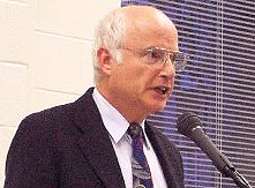 |
|
Professor Michael Gunter |
This paper will seek to reappraise the strategic impact of Armenian
terrorism in the 20th century. What forces drove this particular terrorism, and what led
to its demise? What was its strategic impact if any? With the perspective of time, what
role did Armenian terrorism play in the 20th century's over-all explosion of terrorism as
a means by which the weak could achieve their strategic goals they could not in more
conventional ways? Alternatively, was Armenian terrorism more sui generis, a unique
phenomenon which had no lasting achievement?
Causes
Terrorism is a phenomenon that usually stems from the failure of its perpetrators to
develop sufficient political or military strength to present their case in a more
conventional manner. The inability of the victims to stem it, on the other hand, often
flows from what the well-know cliché explains as, "One person's terrorist is
another's freedom fighter." During the 1984 trial in Paris, France of the four ASALA
agents who seized the Turkish Consulate and killed its Turkish guard in 1981, for example,
the president of the French Court ruled that referring to the defendants as
"terrorists" would not be allowed, since anyone participating in a struggle can
be called a terrorist by someone who opposes that struggle [3].
Clearly, one of the background causes of Armenian terrorism during the 1970s and 1980s was
that too many states and individuals were too lenient on the matter, condemning it in one
breath but apologizing for it in the next by saying, "but we have to understand the
motives."
Although Operation Nemesis, the Armenian terrorist organization that assassinated Ottoman
officials immediately after World War I, disappeared in the early 1920s, "there have
existed for many decades those organizations internationally . . . that are pursuing quite
seriously the Armenian struggle for liberation in every peaceful method available." [4] Eventually some Armenians became frustrated with what
they saw as the unsuccessful peaceful approach and turned to violence.
The deletion of paragraph 30 from a report of the United Nations in 1973-74 is one example
of the failure of the peaceful method. This paragraph specifically mentioned the Armenian
massacres in 1915 "as the first case of genocide in the 20th century," and was
included in a progress report to a study entitled "Prevention and Punishment of the
Crime of Genocide." When Turkey objected during the UN commission on Human Rights,
however, paragraph 30 was deleted, and the Armenians frustrated.[5] Gerard J. Libaridian, a prominent Armenian scholar concluded that
"the unwillingness of the Turkish state and major world powers to recognize Armenian
aspirations after 60 years of peaceful efforts has resulted in a decade of
terrorism." [6] Similarly, the leader of the
Marxist Armenian terrorist group ASALA explained the wave of Armenian terrorism that
occurred in the 1970s, in part, as the result of "the general discovery as to the
failure of the policy of the traditional Armenian parties." [7]
|
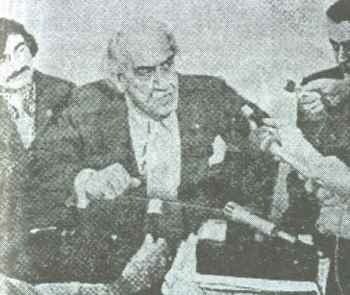
 |
|
Mehmet
Baydar
(1924-1973) |
 |
|
Bahadir
Demir
(1942-1973) |
Gourgen Yanikian, above;
he betrayed his Ottoman nation by joining enemy forces when he was a teen-ager. At the
age of 78, he murdered Mehmet Baydar and Behadir Demir. California Governor George
Deukmejian paroled his paisan eleven years into Yanikian's life imprisonment.
|
In 1965, anti-Turkish demonstrations were organized in Beirut, Lebanon, by the
Lebanese Armenians to mark the fiftieth anniversary of the 1915 Armenian
deportations and massacres by the Ottoman Empire. At this time, the Lebanese
Armenians proclaimed April 24 as "Commemoration Day." [8] On the same day in 1965, thousands of Armenians illegally
demonstrated in Yerevan, the capital of what was then Soviet Armenia. The protest
became disorderly as rocks were thrown, and calm was finally restored only with
difficulty. Since that date, Armenians around the world have commemorated April 24
as Genocide Day. [9]
Another event seminal to the genesis of organized Armenian terrorism occurred on
January 27, 1973. In an individual act of revenge, a 78-year-old Californian of
Armenian descent, Gourgen Yanikian, lured Mehmet Baydar and Behadir Demir, the
Turkish consul general and vice consul in Los Angeles, to a hotel room on the
pretext of presenting them two rare paintings. When the two Turkish diplomats
arrived, Yanikian, who had lost members of his family in Turkey during World War I,
launched into a tirade and then shot both Turks to death. Many feel that this double
murder served as a catalyst for the ensuing decade of Armenian terrorism by ASALA
and JCAG. Indeed, after Yanikian died in 1984, a respected Armenian newspaper in the
United States declared that he had "opened [a] new era of political
struggle" and "changed the course of Armenian history." [10]
Armenian terrorists themselves declared that their campaign began in 1975. In an
interview with the Arab-language periodical Al-Majallah in August 1982, an ASALA
representative stated that his organization's first operation had been in 1975
against an office in Beirut "run by the World Council of Churches, for
promoting the emigration of Armenians to the United States." [11] A miniscule breakaway ASALA group headed by American-born Monte
Melkonian agreed that "the January 20, 1975 bombing of the Beirut office of the
World Council of Churches . . . became know as the act which defined the birth of
ASALA." [12] After one of its agents
murdered Kemal Arikan, the new Turkish consul general in Los Angeles on January 28,
1982, the other Armenian terrorist organization JCAG claimed the deed in a recorded
message over the telephone to the Washington Bureau of the Associated Press, adding
that "our revolutionary struggle began in 1975," [13] apparently referring to its assassination of Danis Tunaligil,
the Turkish ambassador in Vienna, Austria on October 22, 1975.
|
| |
Lebanese-Palestinian Catalyst. The Lebanese Civil War of the mid-1970s acted as
another catalyst for organized Armenian terrorism. As a result of the upheavals of World
War I, Lebanon had come to serve as the host for the largest group of displaced Armenians
in the Middle East. In time, they numbered some 200,000 or approximately 6 percent of that
country's population. [14] Many lived in Bourj
Hammoud, the teeming Armenian quarter of east Beirut, while the Cilician See of the
Armenian apostolic church was headquartered nearby in Antelias. During the 1970s, some
Lebanese-Armenians gradually fell into the internecine power struggles that were to turn
Lebanon into a byword for violence. The nationalist Dashnaks (see below) formed close
alliances with the right-wing Christian Phalangists of Pierre Gemayel and the National
Liberals of Camille Chamoun. Leftist Armenians drew close to Kemal Jumblatt's Progressive
Socialist (Druze) Party and various factions of the Palestine Liberation Organization
(PLO), which had become a state within a state in Lebanon by the early 1970s.
Given the support of their Palestinian allies, radical Armenian leftists created ASALA by
1975. In reaction to these developments, the right-wing Dashnaks created their own
terrorist organization JCAG to keep their young party members from abandoning the ranks
and files to join ASALA. [15] The dissident ASALA
group headed by Monte Melkonian agreed that "the most important and active center of
such political experimentation during this period [1965-75] was Lebanon," [16] and the editor's preface to Melkonian's
posthumously published writings concurred that "during this time several Palestinian
resistance organizations provided their Armenian comrade with extensive military
training." [17]
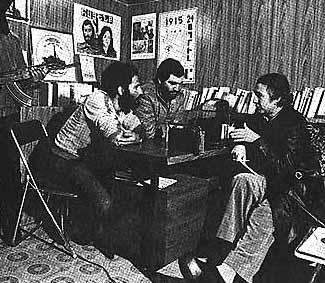 |
|
Gurriaran at
right, interviews Monte Melkonian (left) and
Alec Yenikomshian in Beirut, Dec. 29 1980. The Spaniard
developed sympathy for the Armenian terrorism cause. |
Jose Antonio Gurriaran, a Spanish journalist who had come to know
the Armenian terrorists after being maimed by one of their bombs, wrote that the
"Black September chief Abu Iyad" [18] had
helped ASALA leader Hagop Hagopian form ASALA in 1975. A dissident ASALA source stated
that soon after joining the Palestinians, Hagopian "found himself within the ranks of
Wadi Haddad's splinter PFLP [Popular Front for the Liberation of Palestine]," [19] which was George Habbash's faction in the PLO.
"It was during his activity with Wadi Haddad that he [Hagopian] gained most of his
experience, developed many personal friendships with Palestinian leaders, and began to
mimic the organizational and military tactics of Wadi Haddah," which according to the
same dissident ASALA source cited above, "intentionally caused innocent victims harm,
and thus served to discredit the Palestinian Resistance in general as 'terrorist.'"
The Lebanese catalyst of Armenian terrorism was further illustrated by the fact that so
many of the known terrorists hailed from that country. As Hrand Simonian, a leader of the
Armenian community in Los Angeles, explained, "Many of the terrorists are newcomers
from Lebanon who learned how to do violent things" in the many years of civil
violence there. [20] Similarly, Martin Halabian, the
director of information of the National Association for Armenian Studies and Research in
Cambridge, Massachusetts, stated: "Armenians recently arrived from Lebanon and other
Mideast countries . . . are more used to militancy as a way of life." [21] With this background, this essay will now turn to an analysis of the
two main Armenian terrorist groups that operated from approximately 1975-85.
|
The Dashnaks
|
Background. The Hai Heghapokhakan Dashnaktsuthium or the Armenian
Revolutionary Federation (ARF), commonly referred to as the Dashnaks, was founded in
Tiflis, Russia in 1890. [22] Until Armenia
declared its independence from the Soviet Union in 1990, the Dashnaks were arguably
the preeminent Armenian political organization. The ARF's Manifesto issued in 1891
"sounded like a declaration of war against the Turkish authorities,"
declared a modern Dashnak writer. [23] "To
attain its aims by means of revolution, the Armenian Revolutionary Federation shall
organize revolutionary bands which shall wage an incessant fight against the
[Ottoman] Government," [24] wrote Simon
Vratzian, the Dashnak leader who briefly became the premier of the independent
Republic of Armenia created after World War I, but incorporated into the Soviet
Union in 1921. The resulting fedayeen movement, claims another Armenian
writer, "was a forerunner of the freedom fighters from Iran to Algeria in the
20th century Muslim world." [25]
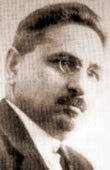 |
|
Simon
Vratsian |
From its inception in 1890, the ARF resorted to
terrorism because of what it perceived as the necessity of self-defense in the
absence of any legal means of protection. According to Mikayel Varandian, an early
party historian: "Perhaps there has never been a revolutionary party-not even
the Russian Narodovoletz, or the Italian Carbonaris — with such rich
experiences in the road of terrorist acts, as the AR Federation, which in its
difficult environment, has developed the most frenzied types of terrorists, and
given hundreds of masters of the pistol, the bomb and the dagger, for acts of
revenge." [26] According to yet another
Armenian source, "terrorism became an act of courage to clandestine
organizations-populists or Dashnaks — a primary response in self-defense,
comparable to war for a Westerner." [27]
Other scholars, while not condoning the massacres which did occur, point out that
since they were the weaker party, the Dashnaks and other Armenian groups began
deliberately to use terror against the Turks to incite Turkish reprisals and
massacres which would then encourage broad Armenian support for revolution and
finally great power intervention. According to the well-known historian William
Langer, "Europeans in Turkey were agreed that the immediate aim of the
[Armenian] agitators was to incite disorders, bring about inhuman reprisals, and so
provoke the intervention of the powers." [28]
Walter Laqueur, a noted authority on terrorism, has concurred: "Since they [the
Armenian terrorists] could not possibly hope to overthrow the government, their
strategy had to be based on provocation. They assumed, in all probability, that
their attacks on the Turks would provoke savage retaliation, and that as a result
the Armenian population would be radicalized; more decisive yet, the Western powers,
appalled by the massacres, would intervene on their behalf as they did for the
Bulgarians two decades earlier." [29] This
terrorism, which was well developed by the beginning of the 20th century, was used
not only against Ottoman officials, but also other Armenians who had run afoul of
the Dashnaks' interests. This pattern continued during the wave of Armenian
terrorism that began in the 1970s, as will be illustrated below.
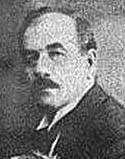 |
|
Armen
Garo |
Operation Nemesis. For a few years in
the early 1920s, a secret Dashnak network known as Operation Nemesis (named for the
Greek god of retributive justice) relentlessly pursued and murdered several former
Ottoman officials living in exile in western Europe. Armen Garo — a former member
of the Ottoman parliament who had deserted to the Russians at the start of World War
I to join the Armenian volunteers fighting against the Ottoman Empire and whose real
name was Garegin Pasdermadjian was "the overall boss of Operation
Nemesis." [30] Shahan Natali (an
Armenian-American from Turkey whose real name was Hagop Der Hagopian) was the
operational coordinator and Aaron Sachaklian was responsible for finances,
logistics, and training. [31]
|
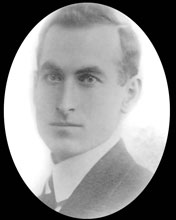 |
|
Soghoman Tehlirian |
Below: "The assassin had lost most of his family in Turkey during World War
I." This is the way Tehlirian indeed perjured himself (along with claiming
that he had three sisters), but it appears
(from his immediate family) that only his mother and one of his brothers lost their
lives during the relocation process, while Tehlirian was busy killing Turks as a
volunteer for the Russians. Another brother had independently also joined the
Russians, and the father and uncles might have been in Serbia, expanding the family
business.
|
Talaat Pasha, probably the most important Ottoman leader in World War I, was gunned
down in Berlin on March 15, 1921 by Soghomon Tehlirian. The assassin had lost most
of his family in Turkey during World War I. The German court found Tehlirian
innocent, a precedent frequently cited by Armenian activists as a moral
justification for murdering Turkish diplomats during the 1970s and 1980s. [32] A Dashnak newspaper, for example, proclaimed
that the trial of the two Armenian terrorists who had killed Galip Balkar, the
Turkish ambassador to Yugoslavia on March 9, 1983, was "becoming like the
Tehlirian trial" in the sense that the accused terrorists could and were
justifying their actions in terms of their political demands against Turkey. [33] Arshavir Shirakian, another Nemesis
operative, assassinated Said Halim, the former Ottoman foreign minister, in Rome on
December 6, 1921, as well as two other leading Ottoman officials-Bahaeddin Shakir
and Djemal Azmi-in Berlin on April 17, 1922. Shirakian then managed to escape to the
United States where he finally died in 1973. [34]
By the summer of 1922, however, the independent Republic of Armenia had fallen to
the Soviet Union. The Dashnaks decided that Operation Nemesis had served its
purpose. Shahan Natali was criticized for the exorbitant expenses that had been
incurred and was eventually expelled from the party in 1929. The so-called
Prometheus plan now sought to use Kemalist Turkey against the Soviet Union, which
had become the new main enemy.
New Terrorism.As noted above, the Dashnaks apparently decided to create a new
terrorist arm, the Justice Commandos of the Armenian Genocide (JCAG) — after July
1983 called the Armenian Revolutionary Army (ARA)-because they were losing their
young, activist members to what was perceived as the new, more dynamic ASALA
terrorist organization. On October 22, 1975, as noted above, JCAG carried out its
first operation when it assassinated the Turkish Ambassador to Austria, Danis
Tunaligil. Throughout 1984, when the diplomatic assassinations stopped, JCAG-ARA
killed 20 Turkish diplomats or members of their immediate families, while ASALA, in
spite of its much greater claims, was responsible for only 8 diplomatic murders. [35] In March 1985, ARA made one last attack when
it killed a Canadian security guard during an attack on the Turkish Embassy in
Ottawa.
Unlike ASALA, the Dashnak terrorist groups shunned other international terrorist
connections and struck only at Turkish targets. After it murdered the Turkish consul
general in Los Angeles in 1982, for example, JCAG announced: "Our sole targets
are Turkish diplomats and Turkish institutions." [36] In pointed contrast to ASALA, ARA also made clear its intention
to campaign against only the Turkish enemy, while leaving others alone: "Our
target is the Turkish reactionary government through all its official
representatives." [37] In another "Communique,"
ARA noted that its activities "will conclude when, taking note of the legality
of the Armenian Cause, the Turkish government begins negotiations with the
representatives of the Armenian people." [38]
The "Political Platform" ratified by the 23rd World Congress of the ARF in
1985, made the ultimate goal of the party explicit: "The principal political
aim of the ARF remains the realization of a free, independent and integral Armenia
encompassing the Wilsonian boundaries, Nakhichevan, Gharabagh [Karabagh], and
Akhalkalak." [39] The Platform also
declared that "on the road to the resolution of the Armenian Cause, our enemy
is Turkey." Placing perhaps impossible barriers before any possibility of
accommodation, the Dashnaks proclaimed that "the continuing existence of the
Turkish empire is fundamentally in opposition with the Armenian Cause," and
concluded that 'the Armenian people had no choice but to resort to self defense to
insure their physical existence and right to self-determination." Indeed,
fifteen years after gaining its independence, Armenia still claims in its
constitution parts of eastern Turkey while occupying Karabagh, which constitutes 20
percent of Azerbaijan. As a result, Turkey has decided not to maintain diplomatic
relations with Armenia.
|
| |
In a further theoretical justification of terrorism, the Dashnak press declared that
"the acts of the Armenian Army and the Justice Commandos against Turkish officials
are supported by a mass of the Armenian people since the Oppressor [Turkey] is being
defied." [40] Armenians "could only be
excited by these acts of violence, as 'acts of creation' since the destruction of any
representative of the Oppressor, Turkey, means the assertion of Armenian dignity."
Claiming an unique right to engage in such actions and denying that they constituted
terrorism, the Dashnaks argued that "our Cause — no matter how militant at times
— is not and never was part of 'International Terrorism.'" [41]
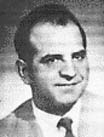 |
|
Kemal Arikan
(1927-1982) |
Similarly, after the JCAG operative, Hampig
Sassounian, was found guilty of assassinating Kemal Arikan, the Turkish consul general in
Los Angeles on January 28, 1982, [42] some Armenians
in Boston announced: "What occurred throughout Hampig's trial was a mockery of
justice, an attempt to stop the Armenian people from actively pursuing their cause. . . .
We are outraged by the . . . guilty verdict." In 2004, an active campaign within the
Armenian community to gain Sassounian's release on parole failed, partially on the grounds
that he still refused to express any remorse for what he had done.
Despite this passionate defense of violence, Dashnak-sponsored terrorism against Turkey
ceased after 1985. In part, this was probably because the ARF had calculated that such
action had served its purpose of preventing ASALA from winning over the Armenian youth,
helped win the Armenian Cause international attention, but was now creating negative
publicity. [43] In addition, the Dashnak-sponsored
terrorism probably stopped because the reputed leaders of the two Dashnak terrorist
organizations had themselves been assassinated during vicious spasms of intra-Armenian
bloodletting in Lebanon. In December 1982, for example, Apo Ashjian, the head of JCAG and
a member of the ARF's Central Committee in Lebanon, was apparently killed by his Dashnak
associates because he advocated Dashnak cooperation with ASALA and sought to disregard a
reputed deal with the United States Central Intelligence Agency to cease activities in the
United States. After Ashjian's death, the Dashnaks created ARA which was active until
before shortly before its head, Sarkis Aznavourian, also a member of the ARF Central
Committee in Lebanon, was gunned down in Beirut, apparently by ASALA. [44]
ASALA
The Armenian Secret Army for the Liberation of Armenia (ASALA) was born in January 1975 as
a distinct alternative to the traditional Armenian political parties, especially the
Dashnaks. As ASALA later explained in its journal Armenia: "International imperialism
had almost completely spread its dominance on our people in the Diaspora through the
rightist Dashnag Party which is a tool in the hands of imperialism and Zionism." [45] Thus, although "the main target of the New
National Liberation Struggle launched in 1975 by ASALA is the liberation of the
Turkish-occupied Armenian lands . . . another main aim of the . . . Struggle is the
political and national awakening of the Armenian people which was led to a dangerous 'deep
sleep' by the treacherous policy of the Dashnag Party." [46] Sarcastically, ASALA declared that "even the name given to their
armed group 'Justice Commandos of the Armenian Genocide' reveals the deliberate
indifference of the Dashnag leadership vis-à-vis the Armenian Territorial Question."
[47]
Thus, although the world ironically saw ASALA as a Marxist, anti-Western terrorist
organization seeking to join eastern Turkey to Soviet Armenia (goals and characteristics
which indeed were true), ASALA first and foremost was created, in its own words, to
"become today the representing power of the Armenian people." [48] Again, in the organization's own words: "We came from different
Armenian currents and circles, and united in ASALA, putting aside all inter-communal
conflicts to serve the principal aim . . . to liberate Western Armenia [Turkey] and join
it to today's liberated Soviet Armenia, forming an integral, revolutionary Armenia." [49]
In its attempt to appropriate the leadership of the Armenian diaspora, ASALA tried to
coopt historical Armenian heroes and deeds. Gourgen Yanikian, whose murder of two Turkish
consuls in California in 1973 anticipated the terrorism that began in 1975, was adopted as
"the spiritual leader" of the organization and operations named for him and such
other historical Armenian heroes and places as Andranik (Ozanian)-an Armenian military
hero in the early twentieth century-, Shahan Natali, Erzurum, and Van, among others.
Andranik's portrait sometimes appeared with a fictional one representing ASALA's leader,
Hagop Hagopian, alongside the masthead of the organization's organ, Armenia. Even Vatche
Daghlian, the leader of the Dashnak's "Lisbon Five," was usurped as an ASALA
"martyr" who had been killed "during a mission in Lisbon, following a
Dashnag-international conspiracy." [50] Further
tapping the Armenian historic roots, "the words of our great [Soviet Armenian] poet
Yeghishe Tcharentz 'O Armenian people/Your sole salvation is/in your collective
force,'" [51] were cited as a call for unity
under ASALA.
|
"Remembering Lisbon Five 22 Years Later "
(This is not part of
Prof. Gunter's article.) ASBAREZ Online reported on
July 27, 2005:
Commemorations
honoring the heroism of Sarkis Abrahamian, Setrak Ajemian, Vatche Daghlian, Ara
Kuhrjulian, and Simon Yahniyan took place at the Bourj Hammoud National Cemetery on
Tuesday. On July 27, 1983, the five men, known as the Lisbon Five, stormed the Turkish
Embassy in Lisbon demanding Turkey acknowledge its 1915 genocide of Armenians. The
five members of the Armenian Revolutionary Federation seized the Turkish Ambassador's
residence and set off explosives which destroyed the building and killed themselves.
In a note delivered to the news media during the takeover, the Armenian Revolutionary
Army (as they called themselves) said: `We have decided to blow up this building and
remain under the collapse. This is not suicide nor an expression of insanity, but
rather our sacrifice to the altar of freedom.' The note also said that they had
resorted to armed struggle because peaceful means for the `pursuit of our just cause'
had failed. Opening remarks at this year's ceremonies in Lebanon were delivered by
Sako Eskidjian who stressed that the five men proved that strong ideals give birth to
a type of heroism that can transform words into action. The keynote speaker Kajhag
Koulajian began by quoting Karekin Njdeh who said, "A people that do not strive
to die a noble death, are not worthy of a homeland—as a homeland is created with the
sacred ashes of martyr's." The message of martyrdom, he stressed, is to die a
deliberate death—to become immortal by etching in the minds of generations, the
sacred traditions—national preservation and cultural development. The speaker turned
to national and Armenian establishments that have instilled and propelled a spirit
that The observance concluded with the singing of "Verkerov Lee."
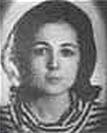 |
|
Cahide
Mihcioglu |
Holdwater notes:
The Lisbon Five killed a Portugese police officer and wounded another. A Turkish
security guard fatally shot one of these "heroes," Vatche Daghlian. Another
account of this deadly episode relates: "As the four remaining gunmen plant
explosives in the residence building, the wife of the Deputy Chief of Mission, Cahide
Mihcioglu, accidentally detonates one of the bombs killing the four gunmen. Mrs.
Mihcioglu also dies in the blast, while her husband Mr. Mihcioglu and son, Atasay
Mihcioglu, survive their wounds."
|
It is noteworthy that ASALA's birth, as mentioned above, was announced by a bombing
attack against the Beirut office of the World Council of Churches on January 20,
1975. Hagop Hagopian, the founder and leader of ASALA, later wrote that "I
chose it because the above mentioned organization was conspiring with the United
States, with the Tashnag's co-operation, to send the Armenian youth away from the
Middle East and socialist countries." [52]
ASALA was going to challenge the existing Armenian elites led by the Dashnaks who
were allowing the emigration and thus assimilation to occur.
By 1980, Hagopian boasted: "In five years we managed to win for ourselves the
support of the Armenian masses and the democratic and revolutionary forces
throughout the world." [53] He even
claimed that "some of the leaders of Tashnag and Henshang [another Armenian
party] have secretly joined ELA [ASALA]."
On September 24, 1981, four ASALA agents seized the Turkish consulate in Paris. They
killed its Turkish guard, wounded the consul, and held 56 people hostage for 16
hours. According to Monte Melkonian, at that time a member of ASALA, this so-called
"Van Operation" by the "Yeghia Keshishian Suicidal Commando"
marked "ASALA's historic peak. It became the greatest single
military/propaganda success ever achieved in the history of the diaspora. . . .
Summed up, this was a tremendous achievement which created a previously unequalled
atmosphere of patriotic enthusiasm and which made ASALA the hope in the eyes of a
vast number of Armenians for the realization of our national aspirations." [54]
After his release from a French prison in the summer of 1986, Kevork Guzelian, one
of the four participants in the Van Operation, discussed it at length. [55] "The essential aim . . . was to gain on political ground
and to turn the attention of international public opinion on Turkey." In
addition, ASALA wanted to "shake the Armenian community in France, which until
1981 was in a slumber." Indeed while they were occupying the consulate, said
Guzelian, "we immediately made an appeal to the Armenians through a phone call
. . . to organize a demonstration around the Consulate and back us up." Since
"about 3,000 Turks had surrounded the Consulate in a demonstration . . .
clashes took place between the Turks and the Armenians in the streets."
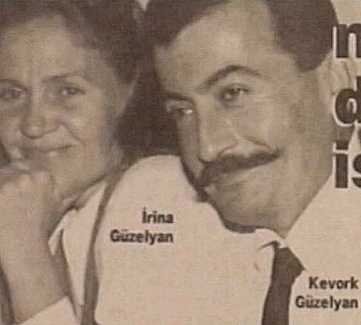
Guzelian claimed that "in one word, after our operation we noticed an awakening
of national awareness in the Armenians in France." French Armenians who did not
speak Armenian started to learn the language. Before 1981, the April 24 Genocide Day
demonstrations in France had brought out no more than 150, but after the Van
Operation the figure rose to 10,000. "This was not due to the activities of the
other [Armenian] organizations . . . found in France but came as a result of ASALA's
national and revolutionary sacrifices."
At the end of 1981, ASALA published an eight-point political program that was
described as "the political line that the Popular Movement of ASALA will
support." [56] The program was apparently
the result of long discussions with the leaders of various "popular
movements" with a view to forming eventually a united organization covering a
broad spectrum from left to right.
In the program, ASALA identified its enemies as "Turkish imperialism"
supported by "local reaction" and "international imperialism."
"Revolutionary violence" was said to be "the principal means" to
achieve the liberation of Armenians territories. ASALA would support those who
"reject the authority of the oppressing classes" and would endeavor to
"strengthen and expand" coalitions within the "international
revolutionary movement." The final goal was a united Armenia with a
"democratic, socialistic and revolutionary government." The Soviet Union
and other socialist governments were to be called upon for help and Soviet Armenia
itself turned into a base for "the long people's war."
ASALA's hope to become the leader of a broad, united front of all Armenian groups,
however, foundered in general upon the increasingly obvious failure of terrorism to
unite the Armenian community, but more immediately upon the frequent Armenian
tendency toward divisive factionalism. The latter problem involved Hagopian's
willingness, even apparent eagerness, to employ indiscriminate terrorism against
non-involved third-party civilians and non-Turkish targets. "In the name of the
Armenian revolution, inhuman operations (i.e. atrocities) were being committed due
to which dozens of innocent people were dying and hundreds of others had been
wounded," [57] declared Monte Melkonian.
The deadly attacks on the Ankara and Paris Orly airports in 1982 and 1983
respectively, and the Istanbul Covered Bazaar in 1983 were three egregious examples.
As Monte Melkonian explained in an interview: "Orly claimed innocent lives. It
debases our struggle." [58] The Israeli
invasion of Lebanon in June 1982, and the resulting expulsion of ASALA from its base
in west Beirut to the relative isolation of the Bekaa Valley, where the organization
fell under increasing Syrian control, also helped lead to the subsequent splintering
of ASALA.
ASALA violently split into two factions following the assassination of Khachig
Havarian and Vicken Ayvazian, two of Hagopian's closest allies, on July 15-16, 1983.
Hagopian blamed Melkonian for the deed — which Melkonian denied — and
reciprocated by killing two of Melkonian's closest friends, Garlen Ananian and Aram
Vartanian. Amid bitter mutual recriminations which are too byzantine to go into
here, as well as deadly infighting against the Dashnaks analyzed above, ASALA
quickly shrunk into insignificance. Hagopian's ASALA lost its allies and contacts
outside Lebanon and, as mentioned above, fell increasingly under Syrian control.
|
|
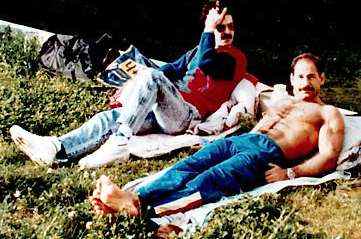
Monte Melkonian flexes his muscles, alongside a Kurdish pal
named Mehmet, on Oct. 1988, in the exercise yard of a French prison. The Armenian hero
was sent to the joint after his arrest in Paris three years prior, for possessing
explosives, a gun, and a fake passport. A web site honoring Melkonian claims his
stretch was for three-and-a-half years, and "he spent months in solitary
confinement, went on hunger strike to demand status as a political prisoner, and
helped organize nation-wide prison rebellions." An Armenian terrorist helping to
instigate nation-wide rebellions? Now where have we heard that, before?
|
Melkonian's hopes for a more humane ASALA under his leadership in the West were dashed by
his sudden arrest and imprisonment in November 1985 in France for three years. A series of
deadly bombings in Paris in September 1986 were at first blamed by many on ASALA in an
attempt to win the release of Varoujan Garabedian, the perpetrator of the deadly Orly
bombing in 1983, but the eventual arrest of the actual perpetrators in March 1987 proved
this to be untrue. ASALA had been reduced merely to issuing proclamations and threats.
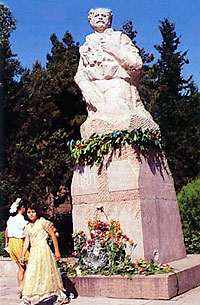 |
|
Melkonian's
monument in Karabakh |
Then on April 28, 1988, Hagop Hagopian himself was
assassinated in Athens, Greece. [59] It was said that
he ironically had been expelled from the now Syrian-controlled ASALA at the end of 1987. [60] A subsequent report claimed that the Syrians had
been behind these events because Hagopian had refused to follow their orders which, among
other things, involved driving booby-trapped trucks into Christian east Beirut for later
explosion. [61] The Syrians were also displeased with
Hagopian's close relations with such Palestinians as Abu Cherif, Abu Iyad, and Fouad Bitar
who operated independently of Syrian influence. A partial rapprochment between Syria and
Turkey at that time also played a role in Syria's actions.
Monte Melkonian was released from the French prison early in 1989 and eventually found his
way to the newly independent Armenia. There he became a noted military leader in the war
against Azerbaijan over Karabagh, which he saw "as crucial for the long-term security
of the entire Armenian nation."[62] He was
killed in a minor skirmish on July 12, 1993, and given a funeral with full military honors
in Yerevan.
Financial Matters
Financial matters, of course, constitute an important issue in studying terrorist
organizations. On this point, ASALA's Hagopian declared: "Our strength is the
Armenian people; that is where we get our support from. And from robberies." [63] Monte Melkonian concurred when he wrote that after
the "Van Operation" on September 24, 1981, Hagopian "went to France to
collect money. . . . Due to the atmosphere, collecting money was not difficult and
considerable sums were acquired." [64] After
Hagopian moved to Damascus to escape the Israeli invasion of Lebanon in the summer of
1982, added Melkonian, "the collection of money . . . [there] within the Armenian
community" also occurred.
The amply publicized fact that the Dashnaks in the United States were able to raise over
$250,000 in small donations for Sassounian's legal defense, [65] as well as some $160,000 in Canada for the defense of the so-called
LA-5, [66] indicates that these claims of broad-based
Armenian financial support are not empty. For the legal defense of the accused murderers
of the Turkish ambassador to Yugoslavia, "fundraising committees have visited
Armenian homes" in Europe and "everyone has been very generous with their
donations" [67] claimed another Dashnak report.
Other reports, however, indicate that the terrorists also extorted funds from fellow,
nonviolent Armenians.[68] Further such evidence
regarding ASALA emerged during the trial of three young ASALA agents, charged with
conspiring to bomb the freight terminal of Air Canada in Los Angeles in May 1982 to gain
freedom for four Armenians held in Canada, and with conspiracy to extort money from
wealthy Canadian-Armenians in Toronto. [69] Vicken
Tcharkhutian — who was apparently involved with the three Armenians on trial, but who
managed to escape to France where the government refused to extradite him back to the
United States — was also charged on a separate count of attempting to extort $150,000
from the Haserjian brothers, the owners of a chain of carpet stores throughout the Los
Angeles area.
In addition, according to Monte Melkonian, ASALA was apparently able to acquire money from
"Abu Nidal and certain governments" by performing "operations as gestures
of revolutionary solidarity." [70] Thus is
explained the bizarre ASALA attempt to bomb the Kuwait Airlines office in Athens from a
motorcycle on December 8, 1982. The plot failed, causing the death of one ASALA agent,
Karnik Vahradian, and the imprisonment of the other, Vahe Khutaverdian. Nevertheless,
Hagopian "used Karnik's death to extract even more financial aid and other 'favors'
out of Abu Nidal and/or some governments." The Athens operation was "portrayed .
. . as proof of the willingness of Armenian revolutionaries to struggle to the death in
cooperation with Arab revolutionaries against imperialism." ASALA, concluded
Melkonian, "had become a mercenary for [other] governments and organizations."
Further reports indicate ASALA was probably also running a "drug ring" [71] and "the huge revenue generated from this
trafficking was being directed for use by the underground radical group." Three
Armenians were convicted for this operation in Sweden and incarcerated.
Testifying before the U.S. Senate's Subcommittee on Alcoholism and Drug Abuse, Nathan M.
Adams, a senior editor of Reader's Digest, who stated he had been investigating
"the connection between drug trafficking and international terrorism . . . over the
past several years," declared: "Armenian terrorist groups of both the left and
the right were estimated a year ago to be 90 percent financed through the sale or barter
of narcotics." [72] Adams then elaborated on
"the case of Noubar Soufoyon, a notorious Armenian drug trafficker now believed
sheltering in Lebanon."
In June of 1981, Soufoyon "was indicted in New York for importing heroin" and
Interpol alerted. The Greek authorities who arrested him, however, rejected an U.S.
application for extradition and chose instead to send him to Lebanon, where he was
promptly released. Soufoyon, testified Adams, "is capable of dealing as much as 100
kilos of heroin at a single time [and] . . . has helped finance both Armenian terrorist
factions with the profits from drug sales." Adams added that Soufoyon "was
convicted in Switzerland of the financing of a series of bomb attacks against Turkish
financial and cultural establishments in Zurich the year before." The Swiss
authorities, however, merely banned him from their country for five years.
Similarly, Francis M. Mullen, Jr., the administrator of the Drug Enforcement
Administration of the U.S. Department of Justice, added: " Documented heroin and
hashish trafficker Noubar Soufoyon was connected with the Justice Commandos of the
Armenian Genocide. . . . He remains a fugitive from U.S. justice and his current
whereabouts are unknown." [73]
|
Conclusion
|
This article has shown that Armenian terrorism was one of the classic examples of
how one person's terrorist could be viewed by some as another's freedom fighter.
From approximately 1973-1985, Armenian terrorists earned a deadly and infamous
international reputation by murdering 30 different Turkish diplomats or members of
their immediate family. In addition, many other non-involved third parties were
killed in the crossfire. Some 188 terrorist operations occurred on four different
continents including western Europe, southwest Asia, North America, and even
Australia. Nevertheless, some among the Armenian public tacitly sympathized with the
terrorists because of what they saw as past wrongs committed by Turkey. As Michael
J. Arlen, Jr., a measured Armenian critic of the terrorism, explained: "It was
as if a particular poison had entered the Armenian system several generations back,
and had remained within it: a poison that one might up to a point live with but that
caused the limbs suddenly to twitch, or the mouth-perhaps in mid-sentence-to grimace
grotesquely." [74]
By the mid-1980s, however, Armenian terrorists had fallen into mindless but deadly
internal fighting that resulted in the deaths of several of their leading members.
Tacit Armenian public support for the terrorism dried up, while shortly afterwards
Armenia's independence from the Soviet Union gave a new generation of Armenian
militants a more reputable cause to support. Indeed, Monte Melkonian, a former ASALA
leader, became a noted fighter in the Armenian war for Karabagh and was killed in
battle fighting for his cause.
From the hindsight of twenty years, it remains difficult to assess definitively the
strategic influence Armenian terrorism had. There were a number of factors which
helped to determine its success or failure. Since Armenians tend to be a closely
knit group, who in their own language distinguish themselves from the odar or
non-Armenian, the Armenian diaspora around the world provided a unique,
transnational system of contacts and support. Given the fact that Armenians tend to
be more successful in the professions than many others, they often possess a
political clout that exceeds their relatively small numbers. In addition, during the
cold war, the fact that the two largest concentrations of Armenians in the world
lived in the Soviet Union and the United States probably gave them more of an input
into the policies of the two superpowers than one would otherwise have suspected.
On the other hand, of course, the Turkic population in the Soviet Union was much
larger than the Armenian. It was unlikely, therefore, that the Soviet Union would
have wanted to be identified by its Turkic populations as being too pro-Armenian.
The hesitancy in acceding to the Armenian demands on Karabagh was a case in point.
On the other hand, although the Armenian population in the United States was much
larger than the Turkish, the strategic importance of Turkey to the NATO alliance
prevented the United States from taking as strong a stand on behalf of the Armenians
as they would have desired. The failure of the Armenians activists in the United
States to pass a "Genocide Resolution" in the U.S. Congress over the years
illustrated this point. Indeed, as recently as April 2005, U.S. president George W.
Bush angered many Armenian-Americans by declining to use the word
"genocide" in commemorating the ninetieth anniversary of the tragedy that
occurred in 1915.
Returning again to inherent Armenian strengths, it should also be noted that
Armenian terrorism against Turkey tended to elicit a certain amount of implicit
sympathy and even tacit support both from Armenians and non-Armenians because of the
widespread belief, referred to above, that the Ottoman Turks ruthlessly massacred
tens of thousands of Armenians in the latter part of the 19th century and then
committed genocide against them during World War I. Add to these damning accusation
that the Islamic Ottoman Empire was one of the leading historical enemies of
Christian Europe, while the Christian Armenians were usually viewed much more
sympathetically — as well as the fact that the Armenians were more fluent in
languages than the Turks and thus able to get their view across to the rest of the
world better — and one can readily appreciate another implicit advantage possessed
by the terrorists. Indeed, twenty years after Armenian terrorism stopped, this
author often finds sheer disbelief on the part of the general non-Armenian public
that the phenomenon even ever existed, that somehow any mention of it is simply part
of the continuing Turkish attempt to blacken the Armenian reputation and deny the
genocide.
The tacit sympathy some Greeks showed for Armenian terrorism stemmed from the
traditional Hellenic hatred of the Turks. The special requiem service held in Athens
in December 1986 for Karnik Vahradian-the ASALA agent, referred to above, who was
accidentally killed during an attempt to bomb the Kuwait Airlines office in Athens
in 1982-further illustrated the situation. At the requiem, Rev. Spiros Tsakalos of
the Greek Orthodox Church delivered a eulogy in which he declared: "The Turkish
fascist regime understands only the language of armed struggle carried out by the
Armenian Secret Army for the Liberation of Armenia." [75]
The situation regarding France was similar, although to a lesser extent, since the
Turks did not conquer and rule that country for 400 years as they did Greece. A
number of French politicians supported Armenian activists because of their electoral
power in certain areas where they were concentrated. On April 24, 1982, for example,
Gaston Defferre, the minister of interior and the mayor of Marseille-which had a
relatively large Armenian population-told them: "France will assist you to
triumph in the pursuit of your just cause." [76]
Even more tacitly condoning the terrorism that was occurring at that time, Charles
Hernu, the minister of defense, told a large Armenian rally in his home city of
Villeurbane on October 10, 1982: "Whenever there are aggressions, we must raise
the question as to who the real aggressor is. Are the aggressors people that
survived a genocide committed by the Turks or the Turks themselves?"
Syrian support for the Armenian terrorists also stemmed from traditional animosities
and especially contemporary political ambitions. The Turkish annexation of Hatay
(Alexandretta) province in 1939, current problems dealing with the waters of the
Euphrates River, and the long-term ambitions of the late President Hafez Assad all
motivated the Syrians to support the terrorists surreptitiously.
In the end, however, the Armenian terrorists also suffered from many problems as
detailed above. In addition, the entire Armenian population in the world numbered no
more than 6 million, while the Turks counted more than 50 million. During the period
of the terrorism, the Armenians also lacked the institutional framework of a state,
while Turkey was a geostrategically important NATO ally of the United States.
Although by practically all conventional standards its ultimate strategic impact was
virtually nil, some might still argue that Armenian terrorism did help preserve the
memory of what many would call the 20th century's first or forgotten genocide.
|
| Endnotes |
1. There is an enormous literature on what
most observers would call the Armenian Genocide, but which Turkey still argues is a
term that is too one-sided to characterize fairly what actually occurred. For the
most part this continuing debate is beyond the scope of this article. For a recent
analysis of what many call the Armenian Genocide, see Rouben Paul Adalian, "The
Armenian Genocide," in Samuel Totten, William S. Parsons, and Israel W. Charny,
eds., Century of Genocide (2nd ed.; New York: Routledge, 2004), pp. 53-90. For a
solid analysis of the conflicting claims that questions whether what occurred can
accurately be called a planned genocide, see Guenter Lewy, The Armenian Massacres in
Ottoman Turkey: A Disputed Genocide (Salt Lake City: University of Utah Press,
forthcoming). Also see Michael M. Gunter, "The Historical Origins of the
Armenian-Turkish Enmity," 4 (Nos. 1 & 2; 1992) Journal of Armenian Studies
(special issue entitled "Genocide & Human Rights"), pp. 257-88, which
concludes that while "there is no doubt the Armenians suffered a great
wrong," (p. 276) "the Armenian claim that they were victims of a
premeditated and unprovoked genocide does not ring entirely true" (p. 277).
2. For previous studies of Armenian
terrorism, see by Michael M. Gunter, "Pursuing the Just Cause of Their
People": A Study of Contemporary Armenian Terrorism (New York: Greenwood Press,
1986); Transnational Armenian Activism Conflict Studies #229 (London: Research
Institute for the Study of Conflict and Terrorism, 1990); "Contemporary
Armenian Terrorism," Terrorism: An International Journal 8 (No. 3; 1986), pp.
213-52; and "The Armenian Terrorist Campaign Against Turkey," Orbis 27
(Summer 1983), pp. 447-77. In addition, see Anat Kurz and Ariel Merari, ASALA:
Irrational Terror or Political Tool (Jerusalem, Israel: Jaffee Center for Strategic
Studies and Boulder, CO.: Westview Press, 1985); and Franics P. Hyland, Armenian
Terrorism: The Past, The Present, The Prospects (Boulder, CO.: Westview Press,
1991).
3. Armenian Reporter (New York), Feb. 9,
1984, p. 2.
4. Armenian National Committee, Los Angeles,
letter to the editor published in Christian Science Monitor, April 3, 1981, p. 22.
5. Paragraph 30 appeared in a report of the
Special Rapporteur to the Sub-Commission on the Prevention of Discrimination and
Protection of Minorities of the Commission on Human Rights of the United Nations
Economic and Social Council, UN Doc. E/CN. 4/Sub. 2/L. 583, June 25, 1973. For a
scholarly analysis, see Leo Kuper, Genocide: Its Political Use in the Twentieth
Century (New Haven and London: Yale University Press, 1981), pp. 219-20.
6. Cited in Christian Science Monitor, Oct.
20, 1983, p. 21.
7. Cited in "Armenian Terrorist Leader
Hagopian Interviewed: Milan Panorama in Italian, 1 Sept. 80, pp. 62-65," in
Joint Publications Research Service: Western Europe, No. 1628, Sept. 24, 1980, pp.
1-6, hereafter Panorama Interview.
8. See Pierre Terzian, "La question
armenienne aujourd'hui," in the special issue of Critique Socialiste 55 (No. 4,
1982) entitled "Armenie du genocide a l'explosion," p. 51. Armenians mark
April 24, 1915, as symbolic of the beginning of the deportations and massacres. On
that date, several hundred Armenian civic, political, and intellectual leaders in
Constantinople were arrested, deported, and eventually executed.
9. For further details, see Ronald Grigor
Suny, Armenia in the Twentieth Century (Chico, CA.: Scholars Press, 1983), p. 78.
10. See Armenian Reporter, Mar. 8, 1984, p.
1. Yanikian was convicted on two counts of murder and sentenced to a life term in
prison. He was released from prison and died less than a month later on February 26,
at the age of 88.
11. "Nadim Nasir Report: Al-Majallah
Visits an Armenian Secret Army Base in Lebanon," in Foreign Broadcast
Information Service (FBIS), Daily Report (Middle East and Africa), Sept. 1, 1982, p.
G8.
12. "Booklet Giving History of ASALA's
Existence Gives New Insight into the Revolutionary Movement," Armenian
Reporter, Jan. 10, 1985, pp. 3 and 10; and the eight subsequent issues. Monte
Melkonian-an Armenian-American born in California on November 25, 1957-became an
important member of ASALA before breaking away from the group in an attempt to form
a more effective organization. He was probably the author of this most revealing
document that was originally published in France under the title "The
Reality" in response to allegations made against it by Hagopian's ASALA group.
Melkonian spoke several different languages fluently and was eventually killed while
leading Armenian troops against Azeris in Karabagh on July 12, 1993.
13. New York Times, Jan. 29, 1982, p. A1.
14. See Christopher Walker, Armenia: The
Survival of a Nation (New York: St. Martin's Press, 1980), pp. 363-67. The following
analysis is based on this source and Andrew Corsun, "Armenian Terrorism: A
Profile,' U.S. Department of State Bulletin, August 1982, pp. 32 ff.; Sato Papazian,
"Sept annes de lutte armee," Hay Baykar (published in Paris, France by the
Mouvement National Armenien Pour L'ASALA), Dec. 22, 1982, pp. 8-9; Terzian, "La
question armenienne aujourd'hui," pp. 51-58; and "Booklet Giving History
of ASALA's Existence."
15. On this point, see Armenian Reporter,
Jan. 5, 1984, p. 1; and its subsequent issue of Feb. 2, 1984, p. 2.
16. "Booklet Giving History of ASALA's
Existence."
17. Markar Melkonian, ed., The Right to
Survive: Selected Writings of Monte Melkonian on the Armenian National Question (2nd
ed.; San Francisco, CA.: Sardarabad Collective, 1993), p. xiii.
18. Robert I. Friedman, "Spanish
Journalist, Victim of ASALA Bombing, Becomes Expert on Armenian Cause,"
Armenian Reporter, Nov. 15, 1984, p. 2.
19. "Booklet Giving History of ASALA's
Existence."
20. Cited in [Armenian]California Courier,
July 28, 1983, p. 7.
21. Cited in Christian Science Monitor, May
6, 1982, p. 5.
22. For a thorough analysis see Louise
Nalbandian, The Armenian Revolutionary Movement: The Development of Armenian
Political Parties through the Nineteenth Century (Berkeley and Los Angeles:
University of California Press, 1963).
23. Manuel S. Hassassian, ARF as a
Revolutionary Party, 1890-1921 (Jerusalem: Hai Tad Publications, 1983), p. 4.
24. Simon Vratzian, "The Armenian
Revolution and the Armenian Revolutionary Federation," The Armenian Review 3
(Autumn 1950), p. 19.
25. Anaide Ter Minassian, Nationalism and
Socialism in the Armenian Revolutionary Movement (1887-1912) (Cambridge, MA.: Zoryan
Institute, 1984), p. 19. In addition, see James G. Mandalian, Armenian Freedom
Fighters: The Memoirs of Rouben Der Minasian (Boston: Hairenik Association, 1963).
The term fedayee refers to freedom fighters in the Middle East organized as
irregulars or guerrillas and comes from an Arab word meaning "those who
sacrifice themselves." Thus, the term has an almost mystical ring to it
redolent of the word martyr.
26. Mikayel Varandian, as cited in K.S.
Papazian, Patriotism Perverted (Boston: Baikar Press, 1934), p. 18.
27. Sarkis Atamian, The Armenian Community
(New York: Philosophical library, 1955), p. 277.
28. William Langer, The Diplomacy of
Imperialism, 1890-1902 (2nd ed.; Boston: Knopf, 1951), p. 157.
29. Walter Laqueur, Terrorism (Boston:
Little, Brown and Company, 1977), p. 44.
30. Jacques Derogy, Resistance &
Revenge: The Armenian Assassination of the Turkish Leaders Responsible for the 1915
Massacres and Deportations (New Brunswick, NJ.: Transaction Publishers, 1990), p.
xxvii. Derogy's book was originally published in French as Operation Nemesis, in
1986 by Librairie Artheme Fayard.
31. Ibid., p. xiv. For further details see
Yves Ternon, The Armenian Cause (Delmar, NY.: Carvan Books, 1985), pp. 98-101.
32. For what purports to be Tehlirian's own
story, see Lindy V. Avakian, The Cross and the Crescent (Los Angeles: De Vorss &
Co., 1965). In addition, see Oliver Baldwin, The Questing Beast (London: Grayson and
Grayson, 1932), pp. 201-204; and Sarkis Atamian, "Portrait of Immortality, Part
II: 'The Hunt,'" Armenian Review 13 (February 1961), pp. 11-21. Tehlirian
finally died in the United States in 1960.
33. "The Belgrade 2 Trial: Becoming
Like Tehlirian Trial," Armenian Weekly, Dec. 24, 1983, p. 1.
34. Arshavir Shiragian, The Legacy: Memoirs
of an Armenian Patriot (Boston: Hairenik Press, 1976).
35. For a list of the assassinations and
who was responsible, see Gunter, "Pursuing the Just Cause," pp. 68-69.
ASALA, however, was responsible for a number of civilian, third-party deaths,
particularly during bloody airport attacks in Ankara in 1982 and Paris in 1983.
36. Cited in Robert Lindsey, "Turkish
Diplomat Is Slain on Coast: Armenian Terror Group Takes Responsibility in
Shooting," New York Times, Jan. 29, 1982, p. A12.
37. "Communique," dated Oct. 12,
1984, and published in the Dashnak newspaper Armenian Weekly, Nov. 3, 1984, p. 2.
38. "Communique," dated Nov. 19,
1984, and published in Armenian Weekly, Dec. 29, 1984, p. 2.
39. This and the following citations were
taken from "Political Platform of the Armenian Revolutionary Federation
Ratified by the 23rd World Congress," Armenian Weekly, Aug. 16, 1986, pp. 1, 7;
and Aug. 30, 1986, p. 1. Nakhichevan and Gharabagh (Karabagh) were then part of
Soviet Azerbaijan, while Akhalkalak was part of Soviet Georgia. Soon after gaining
its independence from the Soviet Union in 1990, Armenia conquered Karabagh and as of
the summer of 2005 still occupies it.
40. This and the following citation were
taken from Aram Khaligian, "The Necessities of Violence and National Culture in
the Liberation Struggle," Armenian Weekly, Dec. 31, 1986, p. 15.
41. This and the following citation were
taken from Tatul Sonentz-Papazian, "The ARF Legacy-Are We Ready?" Armenian
Weekly, Dec. 31, 1986, p. 3.
42. Cited in Armenian Weekly, Jan. 14,
1984, pp. 7, 6.
43. For a fuller analysis of these causes,
see Khachig Tololyan, "Conflict and Decline in Armenian Terrorism," paper
presented at the annual meeting of the American Political Science Association,
Washington, D.C., Aug. 29, 1986.
44. For an analysis of this Dashnak-ASALA
fratricide in Lebanon during the early and especially the mid-1980s, see Michael M.
Gunter, "The Armenian Dashnak Party in Crisis," Crossroads (No. 26; 1987),
pp. 75-88.
45. Armenia, No. 131/13, 1986, p. 10.
46. Moush (Organ of the Armenian Popular
Movement or political arm of ASALA in Greece), No. 13, Autumn 1987, p. 3.
47. Armenia, No. 127-128/11-12, 1986, p.
18.
48. Armenia, No. 105-106/7-8, 1985, p. 29.
49. Armenia, No. 131/13, 1986, p. 7.
50. Armenia, No. 127-128/11-12, 1986, p. 7.
51. Armenia, No. 131/13, 1986, p. 7. For
further analysis of such symbolism, see Khachig Tololyan, "Martyrdom as
Legitimacy: Terrorism, Religion and Symbolic Appropriation in the Armenian
Diaspora," in Paul Wilkinson and Alasdair M. Stewart, eds., Contemporary
Research on Terrorism (Great Britain: Aberdeen University Press, 1987), pp. 96 ff.
52. Armenia, No. 89-90/5-6, 1984, p. 5. I
have taken the liberty of correcting typographical errors in this citation from
ASALA's journal without in any way changing the meaning of the text. ASALA's journal
in Armenian at first also suffered from grammatical errors, but eventually the late
Simon Simonian, an authority on classical Armenian who wrote the language perfectly,
began to edit it. The result was that the quality of the written Armenian radically
improved. I am indebted to Professor Khachig Tololyan for this information. A
picture of Simonian and a trim, youthful-looking Hagop Hagopian appears in the
Armenian Observer, Aug. 31, 1988, p. 12.
53. Panorama Interview. See note 7 for the
full citation to this source.
54. "Booklet Giving History of ASALA's
Existence."
55. This and the following citations were
taken from Armenia, No. 131/13, 1986, pp. 18-19.
56. This and the following citations were
translated from "ASALA'nim Siyasal Programi," [ASALA's Political Program]
Hay Baykar (Paris) (No. 1; 1982). Hay Baykar [Armenian Struggle] was the organ of
the Armenian Popular Movement of ASALA in France.
57. "Booklet Giving History of ASALA's
Existence."
58. "Monte Melkonian Explains His
Break with ASALA: Interview," Armenian Reporter, Jan. 12, 1984, p. 4.
59. "Hagop Hagopian, Legendary Leader
of ASALA, Gunned Down in Athens, Greece," Armenian Reporter, Apr. 28, 1988, p.
1.
60. "Assassination of ASALA Leader Is
Queried by Greek Authorities," Armenian Reporter, May 5, 1988, p. 1.
61. This and the following data were taken
from "Syria Said to Have Caused New Split within ASALA," Armenian
Reporter, Aug. 4, 1988, pp. 1, 2.
62. Melkonian, ed. Selective Writings of
Monte Melkonian, p. xiv.
63. Panorama Interview.
64. This and the following citation were
taken from "Booklet Giving History of ASALA's Existence."
65. See the reports in the [Armenian]
California Courier, Sept. 22, 1983, p. 2; and Dec. 8, 1983, p. 9.
66. Armenian Weekly, Nov. 19, 1983, p. 1;
and Dec. 10, 1983, p. 5.
67. Armenian Weekly, Oct. 1, 1983, p. 1.
68. See "UnArmenian Activities,"
Economist, Feb. 6, 1980, p. 20; New York Times, Apr. 17, 1983, Sec. 1, p. 20; July
31, 1983, p. E2; Aug. 1, 1983, p. A6; and Los Angeles Times, Nov. 12, 1982, part
1-B, p. 9.
69. See the report on this case in the
Armenian Reporter, Aug. 18, 1983, p. 1. The three tried in Los Angeles were
convicted.
70. This and the following citations were
taken from "Booklet Giving the History of ASALA's Existence."
71. For details, see the account in
Armenian Reporter, Aug. 25, 1983, p. 1. For further general background, see Tarik
Somer, "Armenian Terrorism and the Narcotic Traffic," in International
Terrorism and the Drug Connection (Ankara: Ankara University Press, 1984), pp.
19-27.
72. This and the following citations were
taken from the "Statement of Nathan M. Adams Senior Editor of Reader's Digest
August 2, 1984; Room 428 Dirksen Senate Office Building Before the Subcommittee on
Alcoholism and Drug Abuse," (mimeographed), pp. 3-5.
73. "Statement of Francis M. Mullen,
Jr., Administrator, Drug Enforcement Administration U.S. Department of Justice on
Drug-Related Terrorism Before the United States Senate Committee on Labor and Human
Resources, Subcommittee on Alcoholism and Drug Abuse, Paula Hawkins, Chairman,
August 2, 1984," (mimeographed), p. 6.
74. Michael J. Arlen, Jr., Passage to
Ararat (New York: Farrar, Straus & Giroux, 1975), p. 186.
75. "Requiem Service in Athens, Greece
Remembers Youth Said To Have Been Killed by Turkish Agents, 2 December 1982,"
Armenian Reporter, Jan. 8, 1987, p. 15. ASALA falsely claimed that Vahradian was a
victim of the MIT, the Turkish intelligence agency, when in reality he was simply
killed in a bungled attempt to bomb the Kuwait Airlines office.
76. This and the following citation were
taken from "Four French Ministers Friendly to Armenian Cause Severely
Criticized," Armenian Reporter, July 23, 1983, p. 7.
|
| © Michael
Gunter |
See also Prof. Gunter's classic
Pursuing the Just
Cause of Their People
|
|